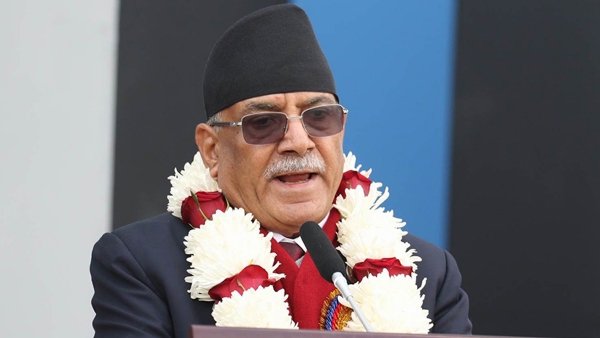#SecurityScan 24: Hindu murder in Pakistan, boom in Indian infrastructure and more
India"s plan of $2 billion incentive for green hydrogen industry will substantially reduce India"s energy dependence from imports and may lead to self sufficiency in energy security.
Total Views |
This article is a summary of important events that have taken place in last one week affecting, India's national security.

NEWS IN BRIEF
One more Hindu lady has been murdered in Pakistan. The Hindus in Pakistan now number few lakhs; it is only a matter of time when there will be no Hindus left in Pakistan.
Brahmos missile with 450 km range has successfully been tested from the Sukhoi fighter aircraft. This missile is an upgrade from the earlier version of 290 km range.
The Intelligence Bureau has started a probe into the death of two Russian oligarch who died accidental death by falling from the third floor of hotel in Bhuvneshwar. They were known critics of Russian President Putin. Putin is known to eliminate his rivals, when they are outside Russia in a foreign country.
Sixteen Indian Army personnel including three Junior Commissioned Officers were killed in a road accident when the vehicle they were travelling in fell into a gorge while negotiating a sharp turn at Zema in North Sikkim.
Three terrorists were killed in an encounter in the Sidhra area of Jammu. The gunfight erupted around 7.30 am .The terrorists were intercepted near Tawi Bridge when they were travelling in a truck to Kashmir.
China has unveiled catamaran drone carrier mothership.The concept brings a slew of operational, institutional, and political challenges.
India could carry out its own assessment and take counter measures.
Chinese ‘gray money’ is making Thai headlines as Chinese criminal elements use drug and gambling profits to buy real estate and political influence in Thailand.
India plans $2 billion incentive for green hydrogen industry
India is planning a $2 billion incentive programme for the green hydrogen industry, in a bid to cut emissions and become a major export player in the field.The $2.2 billion incentive aims to reduce the production cost of green hydrogen by a fifth over the next five years. It would do this in part by increasing the scale of the industry.
This will substantially reduce India's energy dependence from imports and may lead to self sufficiency in energy security.
Southeast Asia nations boosting submarine orders
The growing acquisition of submarines by Southeast Asian countries is driven by China. The Philippine military is beefing up its presence in the South China Sea following reports of new landfill work and mooring by Chinese ships in the area, potentially complicating President Ferdinand Marcos Jr.'s visit to Beijing starting Jan. 3.
Chinese fishing boats, which are militia ships in effect, carried out landfill work at four reef sites around the Spratly Islands.
Good news for India.
Taiwan to extend compulsory military service on China threat
Taiwan has been gradually shifting from a conscript military to a volunteer-dominated professional force, but China's growing assertiveness towards the island it claims as its own,Taiwan will extend compulsory military service to one year from four months from 2024 due to the rising threat the island faces from China. As China ramps up military, diplomatic and economic pressure on Taiwan to assert its sovereignty almost daily Chinese air force is fling over Taiwan. Tsai said the current military system, including training reservists, is inefficient and insufficient to cope with China's rising military threat, if it launched a rapid attack on the island. Conscripts will undergo more intense training, including shooting exercises, combat instruction used by U.S. forces, and operating more powerful weapons including Stinger anti-aircraft missiles and anti-tank missiles.
SOFT POWER
India’s prestigious chain of technology schools set for international expansion
These institutions have laid the academic foundation for the chief executives of some of the world’s iconic firms such as Google, Twitter and IBM. Now the Indian Institute of Technology (IIT), a chain of premier institutions first set up in the 1950s, is aiming for an ambitious international expansion.

Tanzania, the United Arab Emirates (UAE) and Malaysia are three locations these government-funded but autonomous institutes are targeting in the first phase, with Egypt, Qatar and Thailand also under consideration.
This is a step in right direction and will enhance India's soft power at international level.
INTERNAL SECURITY
Infrastructure Boom
India is in the midst of a building boom. It is seeking to modernize roads, rail networks and ports in attempt to vie with China as a manufacturing hub. With China’s construction sector slowing and the US and Europe likely heading into recessions, India has emerged as a consumer of global steel demand. India, overtook the US to become the world’s No. 2 steel consumer after China a couple of years ago. “The nation-building phase of any economy requires a lot of steel and commodities and it could boost the country’s steel consumption to over 200 million tons by 2030.
India produces the vast majority of the steel it uses, but it’s also being forced to import more to meet the surge in demand. Inward shipments rose 15% in April through October from a year earlier to 3.1 million tons, according to government.
Arcelor Mittal Nippon Steel India, a joint venture between India’s Mittal family and the Japanese producer, has plans to more than triple capacity to 30 million tons in the coming decade. South Korean steelmaker Posco Holdings and Gautam Adani, are also exploring setting up mills in the country.
China accounted for more than a quarter of imports in October. The quality of some of the steel coming in is “sub-standard,” Steel Association, has requested authorities look into the matter. “
Despite the strong growth, India is still less than a seventh of China’s 914 million tons. How fast India can narrow the gap will depend on the success of PM Modi’s construction roll-out. $1.4 trillion of funding will be needed for the National Infrastructure Pipeline through 2025.
Domestic manufacturing of high-end components Technological Compnents
The Ministry of Electronics and IT (MeitY) is working on an incentive scheme, with a likely financial outlay of around Rs 10,000 crore to Rs 12,000 crore, to promote domestic manufacturing of high-end components that could go into products such as smartphones, servers and personal computers.
The objective of the components incentive scheme is to develop a complete ecosystem of electronics manufacturing in India. The move may further help attract global majors such as Apple to deepen local production.
Economy in 2022
According to the IMF's October World Economic Outlook, India is expected to clock a highly respectable 6.8 per cent growth in 2022 and top it up with a 6.1 per cent growth in the coming year (2023). This puts it ahead of both the global output and the emerging market and developing economies group. As for the global output, it is likely to be 3.2 per cent (2022) and 2.7 per cent (2023).
Thus overall, has seen the economy performed well in 2022.
Gautam Adani is betting big on India’s growth and believes the country will add a trillion dollars to its GDP every 12 to 18 months within the next decade given its large middle class and young population.
“This century belongs to India,” Adani said. He also sees the India becoming a green hydrogen exporter, adding that a government production-linked incentive plan makes the business viable and attractive.
Food Security-Bajra Dal 2023 as the International Year of Millets
India with the support of 72 countries piloted the proposal in the UN to declare 2023 as the International Year of Millets.
India's push for millets and the UN's recognition of its importance have implications beyond agriculture and food security. Higher nutrition value apart, millets are food crops most suitable for a warming planet.
As a major producer, India must use the year-long attention to create new markets, mainstream production, and create pathways for farmers to increase their earnings.
CAG Slamms DRDO
The Comptroller and Auditor General of India (CAG) has slammed the Defence Research and Development Organisation (DRDO) over delays, cost overruns, and irregular closure of “Mission Mode” projects by declaring them successful despite the non-achievement of one or more key objectives or parameters.
“Mission Mode” (MM) projects are taken up by the DRDO on high priority, based on specific user requirements and with definite timeframes for their completion.

These projects depend on technologies that are already available, proven, and readily accessible within the DRDO or India, or from abroad at short notice. The CAG report, which was placed in the Parliament Thursday, highlighted that there were considerable delays in the initiation and sanction of such projects by the DRDO.
“In 119 out of 178 projects, the original time schedules could not be adhered to. In 49 cases, the additional time was in fact more than 100 percent of the original timeframe. The delays ranged from 16 to 500 percent and that an extension was taken multiple times. “Time overruns in completion of MM projects, where technologies are either available or easily accessible, defeats the purpose of taking them up as an MM Project. “The report has also mentioned that out of 86 projects declared as successful between January 2010 and December 2019, in 20 projects involving an expenditure of ₹1,074.67 crores, one or more key objective(s)/parameter(s) was/were not achieved.
CAG has also noted the “inefficiencies in the planning process” by DRDO as well as raised issues of inadequate monitoring of the MM projects by the DRDO. “There was also a lack of synergy between the DRDO and the Services which resulted in divergent views on the Qualitative Requirements, deliverables, and outcomes of User Trials.
DRDO needs to be made accountable for various projects that it is researching upon. Unfortunately, despite carrying out many reforms, DRDO research projects are a drag on modernization of armed forces. The only solution is increased participation of private industry in research projects.
Controlling Narco Terrorism In 2023
Punjab is emerging as the new epicenter of militancy, arms trade, drug smuggling and targeted killings, with an unholy militant-criminal nexus. In the New Year, the challenge for the government will be to contain Khalistan 2.0 and curb use of cryptocurrency for drug smuggling and terrorism.
Reiterating the Centre’s zero-tolerance policy on the drug menace, Home Minister Amit Shah has announced that big criminals involved in narcotic trafficking would be put behind bars in the next two years. He has admitted that profits from the drug trade are being used to finance terrorism, while expressing concern that the ‘dirty money’ thus generated is hurting the country’s economy. The mapping of drug routes has been done in 472 districts, even as narcotic contraband is entering the country from across the border through drones, tunnels, ports and airports.
Attempts by smugglers to push narcotics have increased during the ongoing winter season, when dense fog envelopes the region. The BSF says it has stepped up vigil near the India-Pakistan border in Punjab, but the frequent seizures don’t seem to be deterring drug traffickers. Most of the drugs smuggled into India originate from the ‘Golden Crescent’ (comprising Afghanistan and parts of Pakistan) and the ‘Golden Triangle’ (including areas of Myanmar, Laos, Vietnam and Thailand). There are reports that the illicit drug trade continues to flourish in Afghanistan under the Taliban regime.
India has proactively used multilateral platforms this year to push for a joint fight against terror funding. There is a need to up the ante and call out nations aiding or abetting narco terror. On the ground, the security forces should be equipped with state-of-the-art counter-drone technology to block the aerial route of drug supply. Synergy among agencies and governments holds the key to breaking the back of drug cartels.
EXTERNAL SECURITY - COUNTERING CHINESE MULTI DOMAIN WAR
Concerns in Khatmandu
Prachanda, was sworn in as Nepal's new PM on Monday. The government is being formed by an alliance comprising Communist Party of Nepal, Communist Party of Nepal (Unified Marxist-Leninist), which is led by the pro-China K P Sharma Oli, and a number of smaller parties. Prachanda ditched the pre-election five-party alliance led by former PM Sher Bahadur Deuba's Nepali Congress and joined hands with bitter rival Oli.
Earlier this year, India bought electricity from Nepal, paving the way for a belated Bhutan model in Nepal. India has stated that it will not buy power from hydropower projects owned by or involving the Chinese.

This alliance does present concern for India given the clear pro-China leanings of the new government. The pro-China leanings are strong even within Prachanda's CPN (MC), with party general secretary Barshaman Pun recently spending two weeks in China. Oli's CPN (UML) will have a critical role in government as it accounts for 78 seats in the 170-member alliance.
The most immediate concern for India is the fate of the West Seti hydropower project. The project was awarded to India by the earlier Deuba government. India will need to make a quick assessment to demonstrate to the new government the benefits of a close relationship with India. India should focus on areas such as education, healthcare, tackling climate change and transition to low-carbon pathway to show that a partnership with India is in Nepal's long-term interests.
ICG and ATS Gujarat seizes Pak boat carrying weapons & drugs worth Rs 300 crore off Gujarat coast, 10 arrested
Indian Coast Guard , in a joint operation with Gujarat Anti-Terror Squad, apprehended a Pakistani boat on Monday with 10 crew in Indian waters carrying arms, ammunition and approximately 40 kgs of Narcotics worth Rs 300 crores. This action was taken on the basis of inputs from the Gujarat Anti-Terror Squad.
"During the intervening night of 25/26 Dec 22, on a specific intelligence input, ICG strategically deployed its Fast Patrol class of ship ICGS Arinjay for patrolling in an area close to the notional International Maritime Border Line (IMBL)," the statement said.
"During the early hours of Monday, 26 Dec 2022, a Pakistani Fishing Boat Al Soheli was observed moving suspiciously in Indian waters. During the investigation, the crew were found to be behaving suspiciously. After extensive rummaging of the boat, the arms, ammunition and approx. 40 Kgs of narcotics worth Rs 300 crores were found concealed.
This was the seventh joint operation by the Indian Coast Guard and ATS, Gujarat in the last 18 months and the first apprehension wherein arms and ammunition along with drugs were being infiltrated."During the mentioned period, a total 346 kgs of heroin worth Rs 1,930 crores has already been seized along with apprehension of 44 Pakistani and 7 Iranian crew.
Coastal police from 9 coastal states and 4 union territories have hardly produced any results up till now .Indian Navy should also carry out intelligent based operation beyond 2000 nautical miles. Mere patrolling has not produced any results. Intelligence based joint operations with police and intelligence agencies is the way ahead.
Chinese drones helping Pak army curb dissent in Balochistan, protect its investments
Pakistan Army launched Operation 'Bolan', a large-scale military operation in the mountain ranges of Bolan, Balochistan in October 2022. The operation in Bolan came after the Baloch Liberation Army (BLA) issued an ultimatum for prisoner swap talks with the Pakistan Army.China had been pressurising the Shehbaz Sharif government about the safety and security of Chinese personnel working in Balochistan. While the Pakistani Army has used fighter jets and armed helicopters against Baloch rebels for several years, a new development is the use of combat UAVs. China provides technology and assisting Pakistan in tracing the locations of the Baloch fighters. At least ten Baloch fighters were killed in a drone attack in Hoshab, Turbat, in the Makran region. China and Turkey have supplied various models of combat UAVs to Pakistan. Pakistan received five Cai Hong 4 (Rainbow 4, or CH-4) multirole medium-altitude long-endurance (MALE) UAVs from China . A Chinese PLA detachment based in Pasni, Gwadar helps the Pakistani military operate these CH-4B drones.
Turn China’s Covid wave into an opportunity
The surge of cases in the China has triggered a unique concern in India. With over 65 per cent of the active pharmaceutical ingredients (APIs) needed by India’s pharmaceutical industry imported from China, the fear of disruption in the supply of these critical raw components of medicines is legitimate. The impending crisis should be turned into an opportunity and act as a catalyst to ramp up the indigenous API sector. Not only will it bring down the dependence on China but also make medicines cheaper.
Given the huge pool of scientists, engineers and drug manufacturers, the potential for its expansion is massive. With a view to tapping into this resource, in 2020, the Union Cabinet approved the Production Linked Incentive (PLI) scheme of up to Rs 6,940 crore for the API sector as part of the Atmanirbharta initiative. However, only 35 APIs, that are imported, had begun under this plan from 32 plants. These 35 APIs are among the 53 for which India has 90 per cent dependence. Expediting the processes needed to start production at the bulk drug park in Himachal Pradesh would also help achieve this goal.

The pandemic provided India the opportunity to showcase itself as a pharmaceutical giant. It stood on a par with the world’s best, becoming one of the few nations to make an anti-Covid vaccine. It boasts of being a pharmaceutical hub as globally, it is the largest provider of generic drugs and fulfils 40% of the generic demand in the US and 25% of the UK’s medicine demand. India has the capability to increase its API capacity.
Chinese will spread Corona all over world
Chinese have turned to black market for generic Indian Covid-19 drugs as surge swept China. Limited supply and steep price of the two approved Covid-19 antivirals are driving many Chinese to opt for cheaper but illegal imports from India.Indian generics have not been approved by the Chinese government and selling them is a punishable offence.
There was mounting pressure on the healthcare system, with doctors saying many hospitals are overwhelmed while funeral parlours report a surge in demand for their services. Nurses and doctors have been asked to work while sick and retired medical workers in rural communities were being rehired to help. Some cities have been struggling to secure supplies of anti-fever drugs. "Some places are facing great pressure at hospital emergency wards and intensive care units.
Chinese people, cut off from the rest of the world for three years by stringent Covid-19 curbs, flocked to travel sites on Tuesday ahead of borders reopening next month. Zero-Covid measures in place since early 2020 - from shuttered borders to frequent lockdowns - last month fuelled the Chinese mainland's biggest show of public discontent since President Xi Jinping took power in 2012. His subsequent abrupt U-turn on the curbs, means the virus is now spreading largely unchecked across the country.
Data from Trip.com showed outbound flights bookings were up 254% early on Tuesday from the day before.
Now lakhs of Chinese will travel to various parts of the world and spread Corona all over the world, as they did earlier. India must ensure that nobody from China is allowed without RT PCR test.
--


